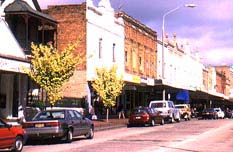
|
| Lithgow's main street
|
Lithgow
Interesting city on the far side of the Blue Mountains
The city of Lithgow is situated 144 km north-west of Sydney
and 920 m above sea-level on the western slopes of the Blue
Mountains. Its history is closely linked with both the large
coal deposits upon which it stands and the extension of the
the railway line over the Blue Mountains in the 1860s.
The Wiradjuri tribe occupied the Lithgow area prior to
white settlement. The valley was given its European name in
1827 by Hamilton Hume, in honour of William Lithgow, the
auditor-general of the colony.
The first substantial settler was Scotsman Andrew Brown
who later founded St Andrew's College at the University of
Sydney. He established 'Cooerwull' station at what is now
Bowenfels in 1824 and built a water-powered mill which he
later converted to steam power by using coal mined on his
property, although the state of road transport over the Blue
Mountains precluded commercial mining.
Construction of a railway line into the Lithgow Valley
began in 1866. At that time there were but five landholders
in the valley. When it was completed in 1869, the Zig Zag
Railway was acclaimed worldwide as a major engineering feat.
It was intended to link Sydney to Bathurst and the
prosperous farming areas beyond the Blue Mountains.
Furthermore, it enabled the industrialisation of Lithgow
(and therefore the establishment of the town) by making the
exportation of coal and iron commercially viable. Not
surprisingly, the railways became the biggest customer for
that coal and iron. Consequently, the road-town of Bowenfels
declined and Lithgow emerged as the railhead for the western
region and the major industrial centre of NSW in the latter
part of the 19th century.
However, the constant change of direction required by the
Zig Zag system imposed limitations upon the length of trains
which could use the line. In the long run this affected the
economic viability of the service and hence of the area's
industry.
Thomas Brown, whose property 'Eskbank' was the
second-oldest in the valley (1835), commenced the first
commercial coalmine the year the railway arrived. Iron was
found on his property and iron smelting began in 1875. A
blast furnace was soon producing 100 tons of pig-iron per
week but efforts were undermined by cheap imports. One of
the company founders, James Rutherford, dynamited the blast
furnace in protest against the lack of protection.
The employees formed a co-operative and leased the works
until William Sandford took over in 1886. He reorganised the
plant, introduced Australia's first galvanising and
corrugating works in 1894 and, in 1900, imported an
open-hearth furnace and successfully puddled Australia's
first steel. He built the nation's first modern blast
furnace in 1907 but went into liquidation in 1908 when
government assistance did not materialise.
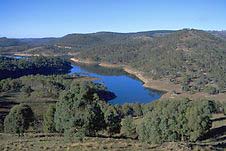
|
| Lake Lyell near Lithgow
|
The next owners, G & C Hoskins, made a great success of
the venture which was employing 632 people by 1909. Poor
industrial relations culminated in a nine-month strike in
1911 which ended in a riot when scabs were brought in.
Nonetheless the demands of an expanding rail system and an
encroaching war saw a second blast furnace opened in 1913.
However, BHP opened a steelworks at Newcastle in 1915 which
had obvious advantages over Lithgow. It was located adjacent
a harbour and the company possessed its own collieries and
ships. There was an insufficiency in supplies of both good
quality ore and coke at Lithgow. In order to compete Hoskins
joined Australian Iron and Steel and relocated to Port
Kembla in 1928. The blast furnaces were removed in 1932
thereby exacerbating local unemployment during the Great
Depression.
Iron and steel were not the only local industry. Thomas
Mort set up a slaughtering and meat refrigeration works in
1875 with the first chilled meat arriving from Lithgow in
1880. In 1876 the Lithgow Valley Colliery set up the Lithgow
Pottery, manufacturing bricks, pipes and domestic items out
of clay. The pottery closed down in 1898 due to the
depression, though pipes and bricks were still made.
Breweries and a copper smelter were amongst the other
local industries. Four brickworks were in operation by 1889
when Lithgow was declared a municipality and there were
seven collieries in 1901. One of the most consistent
businesses and employers was the small arms manufactory
which was opened in 1912. Not surprisingly it was a major
employer during the two world wars.
Lithgow was declared a city in 1945. By that time much of
the heavy industry was gone, although light industry
continued to prosper and the population peaked in the years
just after World War II.
In the late 1950s, a power generating plant was built at
Wallerawang and, more recently, Mt Piper Power Station was
opened near Portland. The stations created a ready market
for local coal. However, since the mid-1980s, reduced
demand, automation and rationalisation have caused the loss
of nearly 2000 jobs in the mining, power and manufacturing
industries which are the city's lifeblood.
Two of Lithgow's best-known offspring are Olympic
sprinter, Marjorie Jackson (known as the 'Lithgow Flash')
and radio and television personality John 'Roy Slaven'
Doyle.
The Lithgow Blues Music Festival is held every year in
November, the National Go-Kart Championships in October and
plans are currently afoot to establish an annual festival
around the time of the Lithgow Show in March.
Things to see:
![[Top of page]](smlArrow.gif)
Tourist Information
The Lithgow Visitors' Centre is situated in the old
Bowenfels railway station at 1 Cooerwull Rd in north-west
Lithgow, tel: (02) 6353 1859. It is open from 9.00 a.m. to
5.00 p.m. daily. Enquiries can be made here concerning local
attractions, operators, accommodation, maps and brochures.
There are also historic photographs and displays of local
arts and crafts. Lithgow Heritage Tours offer guided tours
of the district, tel: (02) 6351 4848.
The attractive sandstone railway station was built in
1869 to accompany the arrival of the Zig Zag Railway. The
charming little Gothic Revival stationmaster's residence
(1869) is made of sandstone and features a steeply pitched
slate roof and ornately carved timber bargeboards.
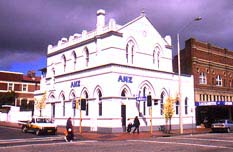
|
| The ANZ Bank in the main
street |
Some Heritage Buildings
De La Salle College (originally Cooerwull Academy) in Rabaul
St is an interesting two-storey Victorian Gothic building
(c.1882) made of dressed stone with an unusual parapet. It
was built by the valley's first European settler, Andrew
Brown, as a training academy for prospective Presbyterian
ministers. It closed when staff enlisted in World War I,
converted to a private residence, and became a Catholic High
School in 1953.
At the Mort and Bridge St intersection is the Hoskins
Memorial Uniting Church, built from 1916-1928 at the behest
of local steel magnate Charles Hoskins, in memory of his son
Guildford who died in an accident in 1916. This Gothic
church was made of Waverley and Pyrmont sandstone, cut and
finished in Sydney and shipped by rail. The furnishings are
of Queensland maple and the striking 30-m spire houses a war
memorial carillon. The landscaped gardens are outstanding.
Diagonally opposite is Lithgow courthouse (1879), a
symmetrical, Federation-style brick structure.
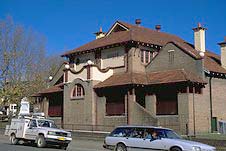
|
| Lithgow courthouse
(1879), a symmetrical, Federation-style brick
structure |
At the corner of Main and Gray is the old CBC Bank, a
Tudor-style building dating from 1883, designed by G.A.
Mansfield. The ANZ building at Main and Eskbank was erected
in 1888.
Small Arms Museum
At the western end of town, in Methven St, is the Small Arms
Museum. It is located in an old section of the Australian
Defence Industry Factory which opened in 1912. Lithgow was
chosen by the Federal Government as the site for the factory
due to its steel and coal production and its distance from
the coast, in case of naval bombardment. A major component
of the local economy, the factory employed 6000 people at
its peak in 1942.
On display is a substantial collection of machine guns,
rifles, pistols and related items from around the world,
including Australian-designed experimental, prototype and
pre-production weapons. There are also non-military wares
produced in the factory, a photographic collection and
memorabilia. It is open weekends and public holidays from
10.00 a.m. to 4.00 p.m. or by arrangement, tel: (02) 6351
4452. .
Pottery
In 1876, the Lithgow Valley Colliery established a brick and
pipe works, using clay near the mine. In 1879 trained
English craftsman James Silcock emigrated to establish the
manufacture of domestic items on the site. But for a brief
revival in 1906, it closed down in 1898 due to the
depression though pipe and brick manufacture continued.
Remnants include a residence and several old brick
structures - the warehouse, flue and clay store. The old
buggy shed is now home to a modern-day pottery selling
hand-made items and a large range of ceramics. The estate is
in Silcock St, off Bent St, behind the Lithgow Valley
Shopping Centre. It is open every day from 10.00 a.m. to
4.00 p.m. Entry is free and there are barbecue facilities,
tel: (02) 6351 4483.
Zig Zag Railway
Chifley Rd heads east out of town until it becomes Bells
Line of Road (convict-built in 1841), which extends to
Richmond. About 10 km east of Lithgow, at Clarence, is the
delightful Zig Zag Railway, acclaimed worldwide as a major
engineering feat when it was completed in 1869. The track
passes over three magnificent sandstone viaducts and through
two hand-hewn tunnels and a cutting, furnishing striking
views over some spectacular natural scenery during its
precipitous descent from the Blue Mountains into the Lithgow
Valley.
The railway enabled the industrialisation of the valley
by rendering the exportation of coal and iron commercially
viable. The railways also provided local industry with its
biggest customer. Consequently, Lithgow became the rail-head
for the western region and the major industrial centre of
NSW in the latter part of the 19th century.
The feat of bringing the railway from the top of the Blue
Mountains escarpment into the Lithgow Valley was
accomplished by John Whitton, engineer in chief of the NSW
Government Railways. Whitton rejected a 3.2-km tunnel.
Instead, he designed a 'Zig-Zag' line - a series of gently
sloping ramps in the form of a letter 'Z' - which would
alternately push and pull trains down the escarpment by
means of specifically arranged grades and bridges.
Although the line was intended primarily for goods trains
it became a major scenic attraction due to the spectacular
scenery, the excellent views and the marvel of the
engineering. An important result of the railway's
construction was the development of locomotive boilers which
could cope with running on hills. This enabled the
construction of mountain railways in other parts of the
world, particularly the Americas.
By the turn of the century rail traffic over the Blue
Mountains was heavy and the single track had become
congested. Consequently a ten-tunnel line was constructed
through the escarpment. It was completed in 1910 and
bypassed the zig-zag line. During the Second World War
Clarence Tunnel was used as an ammunition store. It was
reopened in 1975 due to the work of the Zig Zag Railway
Co-operative.
Steam trains now operate on weekends, public holidays and
most school holidays while a diesel-powered vintage motor
runs during the week. The latter takes in a tour of the
workshop and allows more time to investigate the viaducts
and scenery.
Tickets for the 12-km return journey are $18 for adults,
$15 concession, $9 for children. Trains leave the Zig Zag
Station at Clarence at 11.00 a.m., 1.00 p.m. and 3.00 p.m.
every day of the year except Christmas Day. For further
information ring (02) 6353 1795. A recorded message
outlining the timetable is available on (02) 6351 4826.
The railway is signposted at Mount Victoria and at Bell.
If you are travelling by train from Sydney, inform the guard
at Mount Victoria, or if you are coming from Lithgow, tell
the guard there, and move into the front carriage as the
platform at Zig Zag is short. Bottom Points Station is a
short walk from the main line.
There are numerous picnic and barbecue places along the
line where you can be dropped off and picked up later (speak
to the guard before leaving the Clarence or Bottom Points
stations). There is a shop, as well as picnic and barbecue
facilities at Clarence station where you can also enquire
about bushwalking opportunities.
The Sleigh Inn
The Sleigh Inn sells Christmas decorations from around
around the worlds and offers light meals and refreshments.
It is located 500 m on the Lithgow side of the railway.
Eskbank House
Eskbank House, the oldest building in Lithgow, is open to
visitors, for a small entry fee. To get there, head east
along Inch St, turn left into Bennett St and the Georgian
Cottage is to the right.
Eskbank was built in 1842 of well-dressed sandstone with
stone-flagged verandahs, cedar joinery and a hectare of
beautiful lawns and gardens. The four front rooms are well
preserved and contain some fine early Victorian furniture.
The stables and blacksmith's forge are also of dressed
sandstone while the hexagonal garden house is made of
rock-faced stone. The outbuildings house a Hansom cab and
pennyfarthing bicycle and a locomotive from the old Lithgow
ironworks is displayed in the grounds.
Eskbank was built by Thomas Brown, who became the
valley's second European landholder when he purchased 400
acres around 1835, naming it after the Esk River in
Scotland. He acted as magistrate at the courthouse at
Hartley and opened the area's first commercial coalmine on
his property when the railway arrived in 1869. Brown
represented the district in parliament from 1872 and
remained at Eskbank until 1884.
The covered courtyard at the rear of the house is used as
a museum. Displays include artefacts from the old Lithgow
Pottery (1876-1898) and other memorabilia. The complex is
open Thursday to Monday from 10.00 a.m. to 4.00 p.m or by
arrangement, tel: (02) 6351 3557.
Blast Furnace Park
Further west along Inch St, to the right, is Blast Furnace
Park, the only surviving relic of Australia's first iron and
steel industry. There is some debate about the origin of the
site. Some historians claim that William Sandford first used
it in 1886. There is no dispute that he started to smelt
iron on the site in 1907 after he had built the country's
first modern blast furnace. From 1907 until 1915 it was the
country's only iron production facility. It continued to
produce iron ore until 1928 (for further detail on the
operation see the general introduction).
The site has now been developed as a park around the
remains of the engine house, boiler house, turbines, storage
bins, crane walls, stoves, rail sidings, cooling pond, water
channels, a network of underground tunnels, a large slag
heap and the foundations of the furnaces. A pamphlet
outlines the features in some detail.
Lake Pillans, adjacent, is a rehabilitated wetland area,
through which some walks have been established.
State Mine Heritage Park
Further east along Inch St, Atkinson St heads off to the
left. It crosses over the railway line, becoming State Mine
Gully Road. The industrial park is situated on the original
site of the State Coal Mines headworks, which were
established to supply coal to the railways and other
government departments. It opened in 1916 and from 1921 was
the biggest employer in the western coalfields and one of
the largest in the state. The mine was closed dramatically
in June 1964 as a result of flooding.
There are displays relating to mining history, steam
power and the town's rail heritage. It is open for guided
tours from 9.00 a.m. - 4.00 p.m. on weekends and public
holidays, and at other times by prior arrangement. The entry
fee is $2 for adults, $1 for children and concessions, tel:
(02) 6353 1513.
There are picnic areas at the powder magazines, nature
trails, some fine scenery, flora and birdlife. Plans are
afoot to link the park with the Zig Zag Railway late in 1998
but, at this stage, are still uncertain.
The dirt road continues on past the park, ultimately
leading to the Glow Worm Tunnel (see entry on Newnes).
Oakey Park
If you continue east along Inch St it soon takes you to
Oakey Park, an old mining village which is now a quiet leafy
suburb of Lithgow at the foot of the mountains. Its name
derives from the Scottish term 'oakey' meaning a small
stream.
The houses at 1-10 and 12 Brisbane St and 1-13 Bragg Sts
were originally cottages for the mineworkers. The
blue-roofed house is the original mine manager's residence
and both the Zig Zag Brewery and Zig Zag School remain from
the early days. Other remnants include the foundations of
the coke ovens and the brewery chimney, built c.1912, which
can be seen against the background of the cliff.
The Oakey Park mine was close down in 1897 when the
company tried to cut their employees' pay. Some
strikebreakers were brought from Sydney but they were
stopped 4 km from town by the employees who then raised
enough money to send the scabs back to Sydney
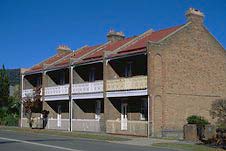
|
| A row of gracious
terraces in Lithgow Street, Lithgow
|
Hassans Wall and Braceys Lookouts
The lookout is located 10 km south of town along Hassans
Wall Rd (take Lithgow St south off Main St and keep to the
left). The highest scenic lookout in the Blue Mountains
(1130 m above sea-level) it was apparently named by Governor
Macquarie after a similar escarpment formation in India.
There are views of Mt Wilson and Mt York to the east, Mt
Tarana and Mt Blaxland in the west and the whole Hartley
Valley below. To the south are the Kanimbla and Megalong
Valleys and Mt Bindo (1363 m).
Proceed past Hassans Wall Lookout and turn left into
Norman Henry Drive to Braceys Lookout from whence there are
fine views over Lithgow.
Archvale Trout Farm
Archvale Trout Farm offers recreational fishing, fresh and
smoked trout and fingerlings. It is located at Marrangaroo,
11 km north of Lithgow via the Great Western Highway. Turn
left into Hughes Lane, just before the Mudgee turnoff. There
are barbecue and picnic facilities. The complex is open, for
a small entry fee, every day from 9.00 a.m. to 5.00 p.m.,
tel: (02) 6352 1341.

Broadwalk
Business Brokers
Broadwalk Business
Brokers specialise in General Businesses for Sale, Caravan Parks for
Sale, Motels for Sale, Management Rights & Resorts for Sale, Farms for
Sale, Hotels for sale,Commercial & Industrial Properties for Sale.
Phone:
1300 136 559
Email:
enquiries@broadwalkbusinessbrokers.com.au
AUSTRALIAN BUSINESSES FOR SALE
COFFS HARBOUR BUSINESS BROKERS
BROADWALK BUSINESS BROKERS
GOLD COAST BUSINESSES FOR SALE
BRISBANE BUSINESSES FOR SALE
SYDNEY BUSINESSES FOR SALE
CARAVAN PARKS FOR SALE
BUSINESSES FOR SALE
MOTELS
FOR SALE
HOTELS
FOR SALE
Disclaimer
We advise prospective purchasers that we take no
responsibility for the accuracy of any information in the business
provided by vendors or their professional advisers and that they should
make their own enquiries as to the accuracy of this information,
including obtaining independent legal and/or accounting advice
Y
Lithgow

